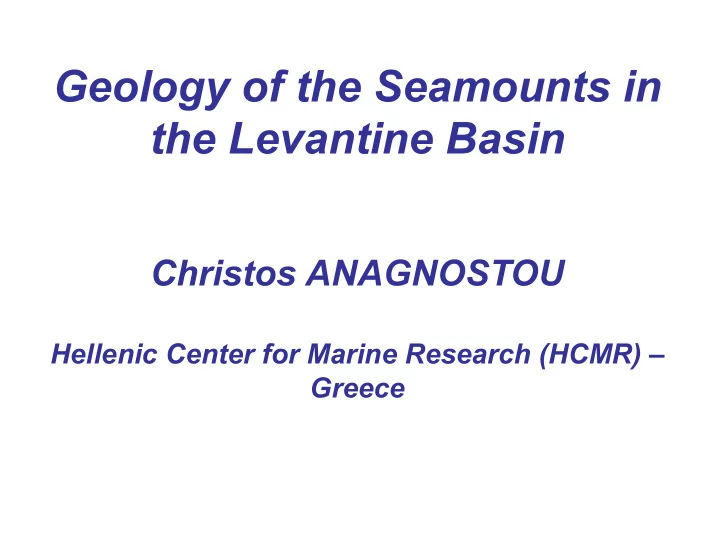

Geology of the Seamounts in the Levantine Basin Christos ANAGNOSTOU Hellenic Center for Marine Research (HCMR) – Greece
The purpose of my presentation is -to outline the geological dynamic of the Levantine Basin and -to focus more on the main geological features of this Basin Presentation made on existing information !!
This approach can build the basis to understand -the recent dynamic of the Levantine marine system and -contributes significantly to understand also the complicated bio- geo-chemical processes in the water- seafloor boundary zone.
Geological history of Mediterranean Sea - Its evolution. Back to the past Some important stages Extensional phase -Late Permian (~250 Ma) -Late Jurassic (~150 Ma) Compresional phase -Late Cetaceous (~80 Ma) -Early Miocene (~20 Ma) -Late Miocene (~6 Ma) (Messinian salinity crisis) -The Mediterranean Sea of today
Late Permian (~250 Ma): -break-up of the Pangea supercontinent, -formation of a New Ocean, the Neotethys Ocean. -Extension phase, development of sedimentary basins, -The Eastern Mediterranean Sea is born!!
~250 Ma Late Permian
~250 Ma Late Permian a
Late Jurassic (~150 Ma): -In the Eastern Mediterranean. Sea, further extension and subsidence, formation of faulting systems and sedimentation, with shallow to deep-marine carbonates. -The initial opening of the Atlantic Ocean, with its branch to NE, creating the Proto- Western-Mediterranean Sea. -The Palaeotethys is progressively “consumed”, due to convergence procedures and to the “collision” of the landmasses. Some relicts of the Palaeotethys Ocean remained.
~150 Ma b Late Jurassic
-Late Cetaceous (~80 Ma): -Opening of the South-Atlantic, this changed the tectonic setting in the “Pangea” system from the extensional state to a compressional dynamic, due to the convergence of the African and Eurasian plate. -This dynamic resulted in the subduction of Africa plate beneath the Eurasian plate. The Western Mediterranean Sea separated from the Atlantic and formed an autochtonous system.
~80 Ma c Late Cretaceous
~20 Ma d Early Miocene
Late Miocene -Messinian salinity crisis 6 Ma
The Mediterranean Sea today
A geo-dynamic cycle Pangea – Tethys – Alpine orogenetic belt – [Relict Mediterranean Sea]
The today Geodynamic of the Eastern Mediterranea Sea
The today Geodynamic of the Eastern Mediterranea Sea
The Mediterranean Sea today
Bathymetry of the Eastern Mediterranean Sea
The main geological features of the Levantine sea
The main geological features of the Levantine sea Seamounts: - Anaximander Seamount - Eratosthenes Seamount - Hecateus Seamount ? Basins: -Herodotus Basin -(E) Levantine Basin Troughs: -Latakia Trough Trenches: -The South Cyprus Trench Thrusts: -Tartus Thrust -Cyprus - Larnaca Thrusts -Kyrenia Thrust zone Lineations: - The Baltim - Hecateus line The Nile Delta Cone Slampings Breman, 2006
Recommend
More recommend